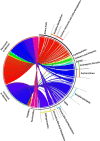Metabolomic differences between critically Ill women and men
- PMID: 33597589
- PMCID: PMC7889607
- DOI: 10.1038/s41598-021-83602-5
Metabolomic differences between critically Ill women and men
Abstract
Metabolism differs in women and men at homeostasis. Critically ill patients have profound dysregulation of homeostasis and metabolism. It is not clear if the metabolic response to critical illness differs in women compared to men. Such sex-specific differences in illness response would have consequences for personalized medicine. Our aim was to determine the sex-specific metabolomic response to early critical illness. We performed a post-hoc metabolomics study of the VITdAL-ICU trial where subjects received high dose vitamin D3 or placebo. Using mixed-effects modeling, we studied sex-specific changes in metabolites over time adjusted for age, Simplified Acute Physiology Score II, admission diagnosis, day 0 25-hydroxyvitamin D level, and 25-hydroxyvitamin D response to intervention. In women, multiple members of the sphingomyelin and lysophospholipid metabolite classes had significantly positive Bonferroni corrected associations over time compared to men. Further, multiple representatives of the acylcarnitine, androgenic steroid, bile acid, nucleotide and amino acid metabolite classes had significantly negative Bonferroni corrected associations over time compared to men. Gaussian graphical model analyses revealed sex-specific functional modules. Our findings show that robust and coordinated sex-specific metabolite differences exist early in critical illness.
Conflict of interest statement
Dr. Chary was a Masters student at Harvard Medical School during the implementation of the study. During her Masters, Dr. Chary was employed at Takeda Pharmaceutical Company and is currently employed by Biogen, Inc. Dr. Chary reports receiving salary and stock options from Takeda and from Biogen. Neither Takeda nor Biogen had any involvement in the VITdAL-ICU trial, the identification of metabolites, the post hoc study design, analysis of metabolomics, interpretation of the data, access to the data or writing of the manuscript. Dr. Lasky-Su served as a consultant and received personal fees from Metabolon, Inc., outside the submitted work. Dr. Amrein reports receiving lecture fees from Fresenius Kabi. Dr. Dobnig reports receiving lecture fees from Fresenius Kabi. Dr. Christopher reports no financial or other relationships that might lead to a conflict of interest.
Figures



Similar articles
-
Metabolic phenotypes and vitamin D response in the critically ill: A metabolomic cohort study.Clin Nutr. 2024 Nov;43(11):10-19. doi: 10.1016/j.clnu.2024.09.030. Epub 2024 Sep 18. Clin Nutr. 2024. PMID: 39307095 Clinical Trial.
-
Metabolomic basis for response to high dose vitamin D in critical illness.Clin Nutr. 2021 Apr;40(4):2053-2060. doi: 10.1016/j.clnu.2020.09.028. Epub 2020 Sep 28. Clin Nutr. 2021. PMID: 33087250 Free PMC article. Clinical Trial.
-
Procalcitonin metabolomics in the critically ill reveal relationships between inflammation intensity and energy utilization pathways.Sci Rep. 2021 Dec 1;11(1):23194. doi: 10.1038/s41598-021-02679-0. Sci Rep. 2021. PMID: 34853395 Free PMC article. Clinical Trial.
-
Nutritional metabolomics in critical illness.Curr Opin Clin Nutr Metab Care. 2018 Mar;21(2):121-125. doi: 10.1097/MCO.0000000000000451. Curr Opin Clin Nutr Metab Care. 2018. PMID: 29251691 Free PMC article. Review.
-
Vitamin D supplementation in the ICU patient.Curr Opin Clin Nutr Metab Care. 2015 Mar;18(2):187-92. doi: 10.1097/MCO.0000000000000147. Curr Opin Clin Nutr Metab Care. 2015. PMID: 25635597 Review.
Cited by
-
Exposomics as a tool to investigate differences in health and disease by sex and gender.Exposome. 2023 Mar 21;3(1):osad003. doi: 10.1093/exposome/osad003. eCollection 2023. Exposome. 2023. PMID: 37122372 Free PMC article. Review.
-
Serum metabolome profiling in patients with mild cognitive impairment reveals sex differences in lipid metabolism.bioRxiv [Preprint]. 2024 Nov 13:2024.11.11.623108. doi: 10.1101/2024.11.11.623108. bioRxiv. 2024. Update in: Neurobiol Dis. 2025 Jan;204:106747. doi: 10.1016/j.nbd.2024.106747. PMID: 39605322 Free PMC article. Updated. Preprint.
-
Sex-Specific Catabolic Metabolism Alterations in the Critically Ill following High Dose Vitamin D.Metabolites. 2022 Feb 25;12(3):207. doi: 10.3390/metabo12030207. Metabolites. 2022. PMID: 35323650 Free PMC article.
-
Metabolomic stratification of shock: pathophysiological insights for personalized critical care.Ann Intensive Care. 2025 Jul 31;15(1):109. doi: 10.1186/s13613-025-01532-1. Ann Intensive Care. 2025. PMID: 40745510 Free PMC article.
-
Circulating N-formylmethionine and metabolic shift in critical illness: a multicohort metabolomics study.Crit Care. 2022 Oct 19;26(1):321. doi: 10.1186/s13054-022-04174-y. Crit Care. 2022. PMID: 36261854 Free PMC article.
References
Publication types
MeSH terms
Substances
Grants and funding
LinkOut - more resources
Full Text Sources
Other Literature Sources

